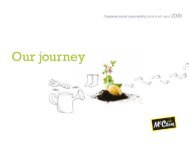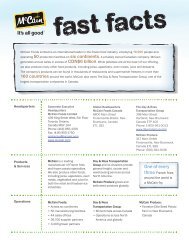From the Ground Up - McCain Foods Limited
From the Ground Up - McCain Foods Limited
From the Ground Up - McCain Foods Limited
Create successful ePaper yourself
Turn your PDF publications into a flip-book with our unique Google optimized e-Paper software.
<strong>McCain</strong>’s Timaru plant, on<br />
New Zealand’s South Island.<br />
As of 2007, Yung was managing <strong>McCain</strong>’s New Zealand business as part of his<br />
job as CEO for Australia and New Zealand. “We don’t call New Zealand <strong>the</strong> seventh<br />
state, as that is offensive to New Zealanders and arrogant on <strong>the</strong> part of Australians,”<br />
he says. Instead, Yung borrows from <strong>the</strong> government of China: “When it took Hong<br />
Kong back, it referred to ‘two countries, one system.’ So here we say, ‘two countries,<br />
one company.’”<br />
The two countries are effectively run as one marketplace out of <strong>the</strong> Ballarat headquarters.<br />
O<strong>the</strong>r than plant managers, <strong>the</strong> only executive based in New Zealand is <strong>the</strong><br />
sales manager for that country. When <strong>McCain</strong> first entered <strong>the</strong> New Zealand market<br />
in <strong>the</strong> 1980s, it ran it as part of <strong>the</strong> Australia operation, but <strong>the</strong> two markets were given<br />
separate management in 1997. They were converted back to one in 2005. <strong>McCain</strong>’s<br />
major customers, such as McDonald’s and Woolworths, <strong>the</strong> supermarket chain that<br />
is <strong>the</strong> largest retailer in Australia, operate in <strong>the</strong> same way.<br />
“The consumers are not different enough to not treat it as one business,” Yung says.<br />
The main difference for <strong>McCain</strong> in <strong>the</strong> New Zealand retail market is that it is not <strong>the</strong><br />
leader, as it is in Australia, but second behind Heinz-Wattie’s. Wattie’s, now owned by<br />
<strong>the</strong> U.S. multinational Heinz, is a well-established New Zealand brand that launched<br />
its business <strong>the</strong>re much earlier than did <strong>McCain</strong>.<br />
Obviously, a company owned by Heinz is not going to be a pushover. Nei<strong>the</strong>r are<br />
<strong>McCain</strong>’s major competitors in Australia. Simplot, ano<strong>the</strong>r major U.S. food company,<br />
now owns Edgell, <strong>McCain</strong>’s chief competitor in french fries and vegetables. In<br />
dinners, <strong>the</strong> main competition comes from Nestlé with its brands Maggi, Findus,<br />
and Lean Cuisine. Nestlé is also a major competitor in <strong>the</strong> pizza category with its<br />
Papa Guiseppe brand. <strong>McCain</strong> is <strong>the</strong> market leader in both food service and retail in<br />
Australia and a strong second in New Zealand, but <strong>the</strong>re is no room for complacency:<br />
all of its major competitors have deep pockets.<br />
John Clements spent seventeen years with <strong>McCain</strong>, running<br />
<strong>the</strong> Australian operation and later, for a couple of<br />
years, serving as a member of <strong>the</strong> <strong>McCain</strong> <strong>Foods</strong> <strong>Limited</strong><br />
board of directors (Opco). He has been able to observe<br />
<strong>the</strong> company’s growth and success, both from a distance<br />
and close-up.<br />
“The secret of <strong>the</strong> success in Australia and worldwide,”<br />
he says, “was <strong>the</strong> way Wallace and Harrison did business.<br />
They were very good delegators, and so we had an<br />
enormous amount of autonomy in Australia. They were<br />
rushing around <strong>the</strong> world opening factories in different<br />
countries and starting new companies, and <strong>the</strong>y didn’t<br />
have large amounts of time to devote to Australia.<br />
“Also, <strong>the</strong>y were always more keen on expansion than on milking <strong>the</strong> company<br />
for profits in <strong>the</strong> short term. There was tremendous willingness on <strong>the</strong> part of <strong>the</strong><br />
two <strong>McCain</strong> bro<strong>the</strong>rs to spend capital and allocate resources to any new project that<br />
looked promising. That suited me too because <strong>the</strong>re were lots of opportunities in <strong>the</strong><br />
frozen food business in Australia.<br />
“For example, although we started off purely in fries, within a short time we<br />
built a pizza plant, a specialty plant, <strong>the</strong>n, by acquisition, we got a full range of frozen<br />
vegetables. Then we went into frozen dinners, where we are <strong>the</strong> market leader.<br />
Then we went into New Zealand and bought companies <strong>the</strong>re and built a french<br />
fry plant.”<br />
<strong>McCain</strong>’s success in Australia is a good example of <strong>the</strong> utility of <strong>the</strong> company’s<br />
“drink <strong>the</strong> local wine” philosophy, which allows it to adapt effectively to each market<br />
it enters. In Britain, consumption of french fries is greater and, consequently,<br />
<strong>McCain</strong> was able to build a strong consumer presence with that product alone,<br />
dropping o<strong>the</strong>r product lines where competitors were strong. Such a strategy would<br />
not have been possible in Australia where, as a result of immigration patterns, rice<br />
and pasta have greater importance in <strong>the</strong> national diet. To build a successful retail<br />
business in Australia required more diversification. <strong>McCain</strong> had no choice: it had to<br />
build strong positions in vegetables, pizza, and dinners to stay profitable.<br />
In 1976, Clements’s first year, <strong>McCain</strong> lost money in Australia. In his second year,<br />
<strong>the</strong> company turned a small profit and has been profitable ever since. During <strong>the</strong><br />
early years, all of <strong>the</strong> profits went back into <strong>the</strong> company to pay for advertising and<br />
marketing.<br />
120 <strong>From</strong> <strong>the</strong> <strong>Ground</strong> up<br />
down under 121<br />
toP: Community<br />
involvement: <strong>McCain</strong><br />
employee Stan Brett is chief<br />
of <strong>the</strong> volunteer Hellyer,<br />
Tasmania, fire brigade.<br />
bottoM: John Clements,<br />
1990.






